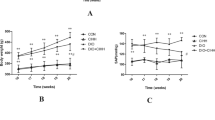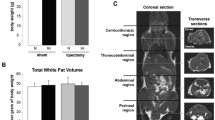Abstract
Background and objectives
The aim of this study was to determine whether chronic intermittent hypoxia (CIH) could affect the secretion of adipokines, such as resistin, leptin, and adiponectin, in non-obese rats and to investigate the potential mechanisms.
Methods
An established rodent model of CIH was utilized, in which rats were exposed to varying oxygen levels (7–21 %) respectively over a period of 5 weeks. The area under the curve (AUCG) and the insulin resistance index (homeostasis model of assessment for insulin resistance index, HOMA-IR) were calculated. The levels of several secretory factors in the blood were measured by enzyme-linked immunosorbent assay (ELISA). The mRNA levels and protein expression in adipose tissues was measured by reverse transcription-polymerase chain reaction (RT-PCR).
Results
Glucose tolerance and the levels of adiponectin in non-obese rats were decreased in the CIH group both in the serum and adipose tissue compared with the controls, while the insulin resistance index and the levels of resistin and leptin were increased. Moreover, the expressions of hypoxia inducible factor-1α and lactate dehydrogenase A were significantly higher in chronic intermittent hypoxia rats than in control rats, suggesting the presence of adipose tissue hypoxia.
Conclusions
These results show that CIH leads to insulin resistance (IR) and impaired glucose tolerance (IGT) in a non-obese rodent model of obstructive sleep apnea-hypopnea syndrome, and these effects may be due to the dysregulation of adiponectin, resistin, and leptin.






Similar content being viewed by others
References
Ip MS, Lam B, Ng MM, Lam WK, Tsang KW, Lam KS (2002) Obstructive sleep apnea is independently associated with insulin resistance. Am J Respir Crit Care Med 165(5):670–676. doi:10.1164/ajrccm.165.5.2103001
Robinson GV, Stradling JR, Davies RJ (2004) Sleep. 6: obstructive sleep apnoea/hypopnoea syndrome and hypertension. Thorax 59(12):1089–1094. doi:10.1136/thx.2003.015875
Vatansever E, Surmen-Gur E, Ursavas A, Karadag M (2011) Obstructive sleep apnea causes oxidative damage to plasma lipids and proteins and decreases adiponectin levels. Sleep Breath 15(3):275–282. doi:10.1007/s11325-010-0378-8
Iiyori N, Alonso LC, Li J, Sanders MH, Garcia-Ocana A, O'Doherty RM, Polotsky VY, O'Donnell CP (2007) Intermittent hypoxia causes insulin resistance in lean mice independent of autonomic activity. Am J Respir Crit Care Med 175(8):851–857. doi:10.1164/rccm.200610-1527OC
Muraki I, Tanigawa T, Yamagishi K, Sakurai S, Ohira T, Imano H, Kitamura A, Kiyama M, Sato S, Shimamoto T, Konishi M, Iso H (2010) Nocturnal intermittent hypoxia and the development of type 2 diabetes: the Circulatory Risk in Communities Study (CIRCS). Diabetologia 53(3):481–488. doi:10.1007/s00125-009-1616-0
Ailhaud G (2006) Adipose tissue as a secretory organ: from adipogenesis to the metabolic syndrome. C R Biol 329 (8):570-577, 653-655. doi:10.1016/j.crvi.2005.12.012
Al MS, Mojiminiyi OA, Al AA, Al RT, Abdella N (2014) Study of leptin and adiponectin as disease markers in subjects with obstructive sleep apnea. Dis Markers 2014:706314. doi:10.1155/2014/706314
Diogo LN, Monteiro EC (2014) The efficacy of antihypertensive drugs in chronic intermittent hypoxia conditions. Front Physiol 5:361. doi:10.3389/fphys.2014.00361
Wang X, Liang L, Junfen FU, Lizhong DU (2007) Metabolic syndrome in obese children born large for gestational age. Indian J Pediatr 74(6):561–565
Ben Y, Chen J, Zhu R, Gao L, Bai C (2008) Upregulation of AQP3 and AQP5 induced by dexamethasone and ambroxol in A549 cells. Respir Physiol Neurobiol 161(2):111–118. doi:10.1016/j.resp.2007.12.007
Chen L, Cao ZL, Han F, Gao ZC, He QY (2010) Chronic intermittent hypoxia from pedo-stage decreases glucose transporter 4 expression in adipose tissue and causes insulin resistance. Chin Med J (Engl) 123(4):463–470
Matsuzawa Y, Funahashi T, Nakamura T (1999) Molecular mechanism of metabolic syndrome X: contribution of adipocytokines adipocyte-derived bioactive substances. Ann N Y Acad Sci 892:146–154
Varady KA, Tussing L, Bhutani S, Braunschweig CL (2009) Degree of weight loss required to improve adipokine concentrations and decrease fat cell size in severely obese women. Metabolism 58(8):1096–1101. doi:10.1016/j.metabol.2009.04.010
Considine RV, Sinha MK, Heiman ML, Kriauciunas A, Stephens TW, Nyce MR, Ohannesian JP, Marco CC, McKee LJ, Bauer TL, Et A (1996) Serum immunoreactive-leptin concentrations in normal-weight and obese humans. N Engl J Med 334(5):292–295. doi:10.1056/NEJM199602013340503
Vidal H, Auboeuf D, De Vos P, Staels B, Riou JP, Auwerx J, Laville M (1996) The expression of ob gene is not acutely regulated by insulin and fasting in human abdominal subcutaneous adipose tissue. J Clin Invest 98(2):251–255. doi:10.1172/JCI118786
Vazquez-Vela ME, Torres N, Tovar AR (2008) White adipose tissue as endocrine organ and its role in obesity. Arch Med Res 39(8):715–728. doi:10.1016/j.arcmed.2008.09.005
Jain SH, Massaro JM, Hoffmann U, Rosito GA, Vasan RS, Raji A, O'Donnell CJ, Meigs JB, Fox CS (2009) Cross-sectional associations between abdominal and thoracic adipose tissue compartments and adiponectin and resistin in the Framingham Heart Study. Diabetes Care 32:903–908
Azuma K, Katsukawa F, Oguchi S, Murata M, Yamazaki H, Shimada A, Saruta T (2003) Correlation between serum resistin level and adiposity in obese individuals. Obes Res 11(8):997–1001. doi:10.1038/oby.2003.137
Vong L, Ye C, Yang Z, Choi B, Chua SJ, Lowell BB (2011) Leptin action on GABAergic neurons prevents obesity and reduces inhibitory tone to POMC neurons. Neuron 71(1):142–154. doi:10.1016/j.neuron.2011.05.028
Menzaghi C, Ercolino T, Di Paola R, Berg AH, Warram JH, Scherer PE, Trischitta V, Doria A (2002) A haplotype at the adiponectin locus is associated with obesity and other features of the insulin resistance syndrome. Diabetes 51(7):2306–2312
Maffei M, Halaas J, Ravussin E, Pratley RE, Lee GH, Zhang Y, Fei H, Kim S, Lallone R, Ranganathan S, Et A (1995) Leptin levels in human and rodent: measurement of plasma leptin and ob RNA in obese and weight-reduced subjects. Nat Med 1(11):1155–1161
Yu JG, Javorschi S, Hevener AL, Kruszynska YT, Norman RA, Sinha M, Olefsky JM (2002) The effect of thiazolidinediones on plasma adiponectin levels in normal, obese, and type 2 diabetic subjects. Diabetes 51(10):2968–2974
Wang B, Wood IS, Trayhurn P (2007) Dysregulation of the expression and secretion of inflammation-related adipokines by hypoxia in human adipocytes. Pflugers Arch 455(3):479–492. doi:10.1007/s00424-007-0301-8
Ye J, Gao Z, Yin J, He Q (2007) Hypoxia is a potential risk factor for chronic inflammation and adiponectin reduction in adipose tissue of ob/ob and dietary obese mice. Am J Physiol Endocrinol Metab 293(4):E1118–E1128. doi:10.1152/ajpendo.00435.2007
Chen B, Lam KS, Wang Y, Wu D, Lam MC, Shen J, Wong L, Hoo RL, Zhang J, Xu A (2006) Hypoxia dysregulates the production of adiponectin and plasminogen activator inhibitor-1 independent of reactive oxygen species in adipocytes. Biochem Biophys Res Commun 341(2):549–556. doi:10.1016/j.bbrc.2006.01.004
Wiesner G, Brown RE, Robertson GS, Imran SA, Ur E, Wilkinson M (2006) Increased expression of the adipokine genes resistin and fasting-induced adipose factor in hypoxic/ischaemic mouse brain. Neuroreport 17(11):1195–1198. doi:10.1097/01.wnr.0000224776.12647.ba
Wang B, Wood IS, Trayhurn P (2008) Hypoxia induces leptin gene expression and secretion in human preadipocytes: differential effects of hypoxia on adipokine expression by preadipocytes. J Endocrinol 198(1):127–134. doi:10.1677/JOE-08-0156
Bedessem B, Stephanou A (2014) Role of compartmentalization on HiF-1alpha degradation dynamics during changing oxygen conditions: a computational approach. PLoS One 9(10):e110495. doi:10.1371/journal.pone.0110495
Semenza G (2002) Signal transduction to hypoxia-inducible factor 1. Biochem Pharmacol 64(5–6):993–998
Acknowledgments
This study was funded by Shanghai Committee of Science and Technology (No. 13430720500), Shanghai Leading Academic Discipline Project (No. B115), and National Natural Science Foundation of China (No. 81472175).
Conflict of interest
There is no financial or personal relationship with other people or organizations that could inappropriately influence this work.
Ethical approval
All applicable international, national, and/or institutional guidelines for the care and use of animals were followed. The manuscript does not contain clinical studies or patient data. All animal studies have been approved by the appropriate ethics committee and have therefore been performed in accordance with the ethical standards laid down in the 1975 Declaration of Helsinki, as revised in 1983.
Author information
Authors and Affiliations
Corresponding authors
Additional information
Cuiping Fu and Liyan Jiang contributed equally to this work.
Rights and permissions
About this article
Cite this article
Fu, C., Jiang, L., Zhu, F. et al. Chronic intermittent hypoxia leads to insulin resistance and impaired glucose tolerance through dysregulation of adipokines in non-obese rats. Sleep Breath 19, 1467–1473 (2015). https://doi.org/10.1007/s11325-015-1144-8
Received:
Revised:
Accepted:
Published:
Issue Date:
DOI: https://doi.org/10.1007/s11325-015-1144-8




